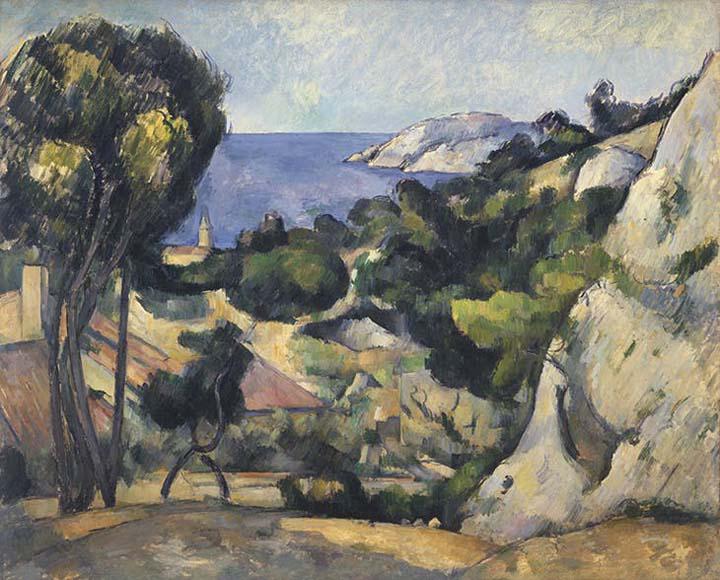Cezanne: Rock and Quarry Paintings
One of the exhibition casualties of the Corona19 pandemic is the tightly focused, small, gemlike exhibition, Cézanne: The Rock and Quarry Paintings, organized by the Princeton Museum of Art. The exhibition, comprised of just 19 paintings, drawings and watercolors by Paul Cézanne [1839-1906], together with a number of black-and-white photographs of the sites where he made the works, opened on March 7, 2020, only to close a few weeks later. It was to have traveled to the Royal Academy of Arts, London, in July, but that venue was also canceled. Above: Montagne Sainte-Victoire Seen from Bibemus, 1895-1900
What remains, however, is the exceptional catalog, with a major essay by curator John Elderfield surveying the evolution and workings of Cézanne’s artistic practice in the creation of these canvases; an essay on the geological context of the work by Faya Causey and introductions to the sites at which Cézanne painted by Anna Swinbourne, both independent scholars; and catalogue entries by Sara Green, Annemarie Iker and Ariel Kline, graduate students in the department of art and archaeology at Princeton University. In addition, the museum website includes videos of the opening night lecture by Elderfield, together with artist Terry Winters, and a virtual exhibition tour narrated by Elderfield.
In discovering Cézanne fascination with geology and evolution—two scientific fields newly reaching the French public towards the second third of the 19th Century, Elderfield has magically equalized, through scholarship and leaps of the imagination, what the artist himself was doing in equalizing the motif and the materiality of his work and process. From around 1866, he teamed up with a younger friend, the geologist Antoine-Fortuné Marion, to study rock formations, which they both drew and painted on excursions tol”Estaque, not far from their hometown of Aix-en-Provence. In one of the earliest of these paintings, Rocks at the Shore, l'Estaque, ca. 1866 [above] Cézanne built up a rough slab-like surface with a palette knife, which one of his friends jokingly called his “mason’s tool”, in earth colors that came from the local soil.
The show is organized in three sections based on the primary locations where Cézanne worked: l’Estaque, near Marseille; the Bibemus Quarry, near Aix; and the forest at Fontainebleau, outside of Paris. In the l’Estaque group of four works, a view looking down a steeply pitched jumble of cracked limestone boulders [above] sets the pace for what later unfolds during the artist’s days at Bibemus Quarry and Chateau Noir. The origin of his working method, which he said involved “making one stroke after another” can be seen in the ways in which he combines faithfully realized versions of nature’s creation of rocks and trees with his abstraction of forms that were too distant to make out. Above: Rocks at the Shore, l'Estaque, ca. 1866
A rectangular area in the lower center right area of the painting above demonstrates the way in which he transformed the indistinct shapes of what might be a compound of buildings. It also suggests that Cézanne deliberately chose to let nature be the main feature in these works created over a span of 40 years. Even in his sketchbook drawings, there is never a human or animal figure to offer a sense of scale. It is only through the presence of a slender pine tree audaciously growing up through fractured boulders [Cat. 9: Rock and Trees, 1909, Fountainebleau] that we begin to understand the massiveness of the geologic forms that engaged his senses over the years.

The more that this subject matter inhered in his work, the greater became Cézanne’s ability to concentrate the materialization of his intellect and observational powers. His palette of oil colors grew increasingly restrained, limited to enough colors to create what he called a “harmony parallel to nature”, in this case, the artistic re-enactment of earth, rock, tree, sky. Even his application of oil paint became thinner, in a way getting down to the most elemental nature of the forms he saw.
Cézanne: The Rock and Quarry Paintings, organized by the Princeton Museum of Art. Info
The Princeton University Art Museum offers a virtual tour of the exhibition. This video is narrated by curator John Elderfield, who served from 2015 to 2019 as the inaugural Allen R. Adler, Class of 1967, distinguished curator and lecturer at the Princeton University Art Museum, and is chief curator emeritus of painting and sculpture at the Museum of Modern Art.
The catalogue, which includes many more related paintings, drawings, watercolors and photographs, is a must-have. Printed on dull coated paper, with images spot varnished, the book has a natural linen cover with the title debossed in gold foil and a French folded jacket. Info
The Museum’s galleries are closed to visitors as it prepares for construction of the new Museum, designed by architect Sir David Adjaye and anticipated to open in late 2024. Info





